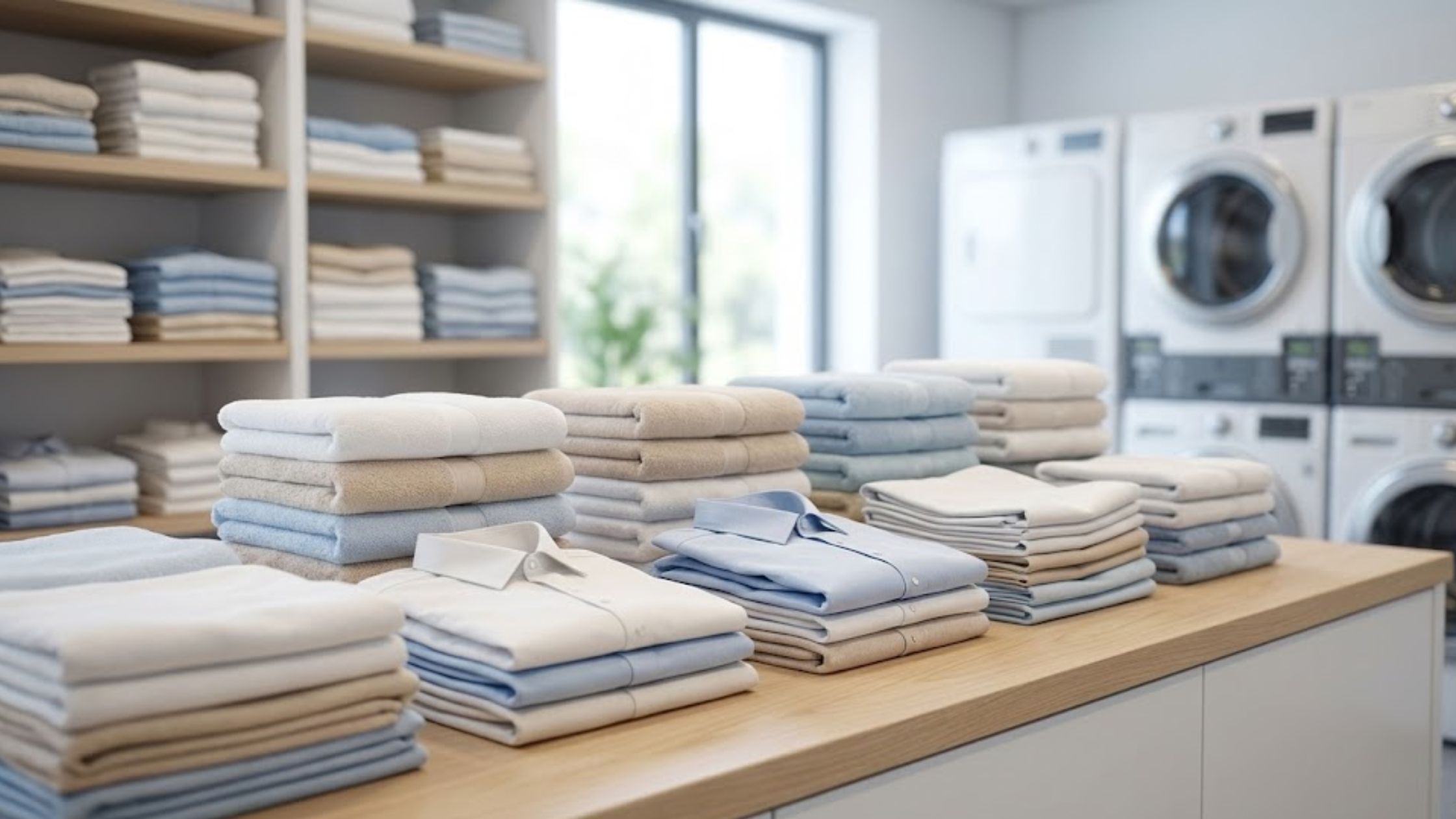To get grease stains out of clothes, start by blotting the stain with a paper towel to absorb excess oil. Apply a small amount of grease-cutting dish soap or an enzyme stain remover, gently work it into the fabric, and let it sit for 10–15 minutes. Rinse with warm water, then wash with the best stain remover for grease in warm water safe for your fabric. If you’re using a professional Washing Service in Manville, RI, be sure to mention the stain type for optimal treatment. Always air-dry before checking the heat from dryers, as heat from dryers can permanently set oil stains. Grease may look permanent, but with the right products and steps, you can make even set-in stains disappear without harming your fabric.
In this blog, we’ll cover easy step-by-step methods for both new and old grease stains and provide tips to help your wardrobe look spotless again.
What’s the Best Way to Remove Grease Stains from Clothes?
The best way to remove grease stains from clothes is to treat them quickly using products that break down oil at the fiber level. The best stain removers for grease include dish soaps with surfactants, enzyme-based pre-treaters, and oxygen-powered boosters. These formulas lift grease particles before they permanently bond to the fabric. Always blot, pre-treat, and wash in the warmest water safe for your garment, then air-dry to prevent the stain from setting.
Quick Steps for Effective Grease Removal:
- Blot fresh grease with a paper towel.
- Apply a few drops of dish soap or an enzyme remover.
- Let it sit for 15-30 minutes.
- Wash in the warmest water safe for the fabric.
- Air-dry and check before using a dryer, since heat can set the stain.
Repeat if needed. Patience beats power when tackling oil.
Why Grease Clings to Clothes and What Removes It?
Grease clings to clothes because it’s hydrophobic, meaning it repels water. The molecules in oil and fat don’t dissolve in water, so a normal wash cycle simply pushes the stain around instead of lifting it. The secret to breaking this bond lies in using surfactants, enzymes, and oxygen-based cleaners designed to emulsify oil and water. It allows grease to be completely lifted away. This is how to remove grease stains effectively without damaging your fabric.
How Grease Sticks:
- Water-repelling structure: Grease is made of lipids (fats) that resist water and bind tightly to fabric fibers.
- Tacky texture: The sticky, fatty layer traps dirt, dust, and odor, making stains grow darker over time.
- Heat bonding: Warm kitchens or dryers can melt oil deeper into fabric, creating “invisible stains” that reappear later.
How To Remove It (Proven by Chemistry):
- Surfactants in dish soap have a dual structure, one end loves oil, the other loves water. They form micelles that pull grease away from fibers, allowing it to rinse out easily.
- Enzymes in laundry pre-treaters digest organic fats and oils at the molecular level, loosening stains even in cooler water.
- Oxygen boosters (like OxiClean) release oxygen bubbles that lift residue and restore brightness without harsh bleaching.
- Warm water softens oils, letting these active ingredients penetrate deeper and work faster.
That’s why combining these methods gives professional results at home.
How to Get Fresh Grease Stains Out of Clothes Step by Step?
To remove fresh grease stains from clothes, blot the spill immediately, apply a few drops of dish soap or enzyme remover, and rinse with warm water before washing. Always air-dry first; heat from dryers can permanently lock oil into fabric fibers. Repeat if needed for complete stain removal. When it comes to everyday spills from cooking splashes to automotive grease on workwear, each step matters. These simple techniques make it easier to remove grease stains from clothes before they set, keeping your wardrobe looking spotless
Here’s a detailed breakdown to help homeowners in Manville treat fresh grease properly before it sets.
1. Blot the Stain Before It Spreads
Act within seconds. Use a clean napkin, paper towel, or cloth to absorb surface oil before it penetrates deeper. Avoid rubbing it pushes the stain further into the fabric and makes removal harder.
- Press gently with an absorbent paper towel or cotton cloth.
- Work from the outer edge toward the center of the stain.
- Replace towels as they become saturated with oil.
2. Apply a Grease-Cutting Cleaner
Once most of the oil is lifted, apply a few drops of grease-fighting dish soap or enzyme pre-treater. Surfactants in these products break the bond between oil and fabric, allowing it to rinse cleanly during washing.
- Use a small amount, just enough to cover the spot evenly.
- Massage gently with your fingers or a soft-bristle toothbrush.
- Let it sit for 10–15 minutes to activate grease removal.
3. Rinse Thoroughly with Warm Water
Warm water helps loosen oil molecules and flush out surfactant-lifted grease. Rinse the back of the fabric to let the oil flow outward rather than deeper into the fibers.
- Use lukewarm water (not hot) to prevent fabric damage.
- Rinse until the water runs clear and the soap residue disappears.
- Pat dry with a clean towel to remove moisture before washing.
4. Wash on the Warmest Safe Setting
Now, wash the garment with your regular detergent in warm water safe for that fabric. Warm temperatures boost detergent performance and dissolve leftover oil traces. Check your care label before washing.
- Add a heavy-duty detergent for maximum grease breakdown.
- Choose a stain-removal or deep-clean cycle if available.
- Avoid overloading the washer; give garments space to agitate.
5. Air-Dry and Inspect Before Using Heat
After washing, let the garment air-dry naturally. Grease can appear invisible when wet, so inspect the fabric under light once it’s dry. Only use the dryer when the stain is fully gone.
- Hang-dry in a well-ventilated area, avoiding direct sunlight for delicates.
Examine under bright or natural light for any shadow. - If you spot residue, repeat the cleaning cycle before drying.
What’s the Right Way to Remove Grease Stains from Different Fabrics?
The right way to remove grease stains depends on the fabric’s texture, absorbency, and heat tolerance. Each material reacts differently to soap, water, and enzymes. While sturdy fabrics handle warm water and deep cleaning, delicate fibers like silk or wool need gentle, low-temperature treatment to prevent shrinkage or discoloration.
Different fabrics require unique cleaning chemistry. Cotton lifts oil easily with detergent, polyester traps it without pre-treatment, and wool needs delicate handling to avoid fiber damage.
Here are some quick, easy tips described in the table below:
| Fabric Type | Best Treatment | Water Temp | Avoid |
| Cotton & Denim | Dish soap + enzyme pre-treat | Warm | Bleach on colored fabric |
| Polyester & Activewear | Enzyme spray + oxygen booster | Warm | Fabric softeners (trap grease) |
| Silk & Wool | Baby powder + gentle hand wash | Cool | Enzyme products (can weaken fibers) |
| Workwear / Uniforms | Grease-busting foam + warm wash | Warm | Air drying too soon |
In Manville, restaurant workers and mechanics often face repeated grease issues. Using enzyme pre-treaters weekly can prevent buildup and odors.
For a step-by-step breakdown, check out our guide on how to clean washing machine the right way.
Why Manville Homes Trust Laundry Lady to Remove Grease Stains?
After learning how fabrics respond differently to grease, many homeowners around Railroad Street in Manville realize that some stains just won’t budge with home methods alone. That’s where the experts step in.
Grease from cooking, car repair, or restaurant uniforms can soak deep into fibers, leaving dull spots and lingering odors no matter how many times you wash. Laundry Lady solves this by using advanced cleaning chemistry to remove grease stains from clothes with convenient local pickup, restoring fabrics to their original look and feel.
Here’s why Manville residents rely on Laundry Lady:
- Professional enzyme soaks dissolve deep-set grease and food oils without fading fabric color.
- Commercial-grade oxygen boosters safely lift heavy stains and brighten whites and uniforms.
- Pickup & delivery service around Manville, Cumberland, Woonsocket, and Lincoln saves time for busy households and local businesses.
From aprons and work uniforms to everyday clothing, Laundry Lady delivers spotless, grease-free results that DIY methods can’t match. Call +1 (401) 429-6341 or schedule your pickup at Laundry Lady.
Conclusion
Grease stains don’t have to ruin your favorite outfit. With the best stain removers for grease, dish soap, enzyme pre-treaters, baking soda, and oxygen boosters, you can restore clothes to like-new condition. Always start with absorbent blotting, pre-treat properly, wash in the warmest safe water, and air-dry before checking results. If time’s short or the stain’s stubborn, Laundry Lady is here for you. From Railroad Street in Manville to homes across Rhode Island, we handle grease, oil, and tough laundry challenges every day.
Schedule your pickup today and let Laundry Lady bring your clothes back fresh, clean, and grease-free!
Frequently Asked Questions (FAQs)
1. Can I remove grease stains from clothes that have already been washed and dried?
Yes, it’s tougher, but still possible. Use a multi-step “rescue loop”: apply an absorbent (like baking soda), brush off, then treat with enzyme pre-treater, soak (with oxygen booster if possible), wash in warm water, and air-dry before using heat.
2. What is the best stain remover for grease stains?
The most effective options include surfactant dish soaps, enzyme pre-treaters, and oxygen boosters. These work together to break down oil, lift it from fibers, and rinse it out. Use the warmest water safe for the fabric, and repeat if any residue remains.
3. Does vinegar or baking soda remove grease stains?
Baking soda can act as an absorbent to draw oil out, and vinegar (diluted) may help loosen residue, but they’re not powerful enough on their own. Combine them with a grease-cutting soap or enzyme cleaner for full effect.
4. Will dish soap always remove grease from clothes?
Often yes, especially on fresh stains. Dish soap contains surfactants that bind oil and let it rinse away. For older or tougher stains, add enzyme and oxygen treatments to boost removal.
5. How hot should water be when washing grease-stained clothes?
Use the warmest water safe for your fabric (as per the care tag). Heat helps liquify oil, allowing cleaning agents to penetrate deeper. Avoid exceeding fabric limits to prevent damage.




